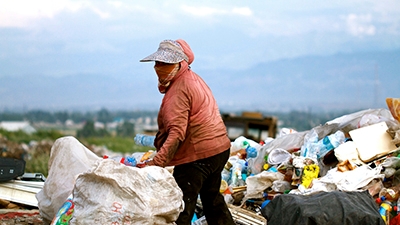Katya, 45, is one of millions of people in the Kyrgyz Republic who spend most of their meager incomes barely managing to feed their families enough to survive the region’s long, frigid winters.
Often, even that can be quite a challenge.
Katya’s salary as an elementary school teacher is about 5,600 som ($110) per month. She earns another 1,650 som ($32) every month cleaning classrooms in the evenings. Her husband’s income as a construction worker is about 7,000 som ($137) every month and their daughter, who works in the Russian Federation, sends 9,700 som ($200) per month to support her two small children who live with Katya.
But she is left with almost nothing after paying for basic groceries such as bread, dried noodles and potatoes. Whatever she has left, she uses to pay for bus fare to get to work and back, and for her grandchildren’s medical expenses. At the moment, Katya owed about 800 som ($16) at the local grocery store.
The region’s long, harsh winters means families have to pay a lot more to stay warm and eat enough calories to survive such unrelenting conditions, compared to other, warmer parts of the world. On a daily basis, these costs add up, and $2.50 per person is often not enough. Consequently, many of these families live in poverty.
The World Bank interviewed several families in the region to document the issues that the poor face. While all of them said high heating bills a big problem, they also found it equally difficult to buy enough food. Colder weather means people need more calories – often meaning more food – to survive such conditions.
Katya’s daughter moved to Russia, leaving her two young children behind just so she could find long-term employment and a steady, even if modest, income. She sends a significant portion of her income to Katya in order to support her children.
But many others don’t even have the option to leave, and are left trying to make ends meet however they can.
Bermet, 66, is one such example. She lives with her family of 13, including her husband, two adult children, a daughter-in-law, and eight grandchildren just a few houses away from Katya.
Bermet’s total household income is a little over 20,000 som ($392) per month. That includes the 8,000 som ($156) she and her husband receive as pension, and 12,000 som ($235) her daughter earns as a tailor. Occasionally, one of Bermet’s daughters sends 2,000 som ($39) their way.
The 20,000 som ($392) disappears quickly each month when Bermet buys just the bare necessities for her big family – flour, soap, cooking oil, and noodles. Often, the family eats just cooked macaroni and bread for lunch.
In the Kyrgyz Republic, an average person who lives on less than $5 per day ends up spending nearly 55 percent of his or her total income on food, according to World Bank research.
Recently, Bermet’s husband’s medical condition required them to extend the house to accommodate his needs, putting them 100,000 som ($1,961) in debt for the construction costs.
“We save on food, we have no choice,” she said. “If we don’t repay the loan, they will take the house. We would like to have meat, vegetables, and jam, but we cannot have any of that. We can't get medical tests done either.”
For now, Katya, Bermet, and millions more like them would be happier if they didn’t have to worry about the next day’s food for their families.


